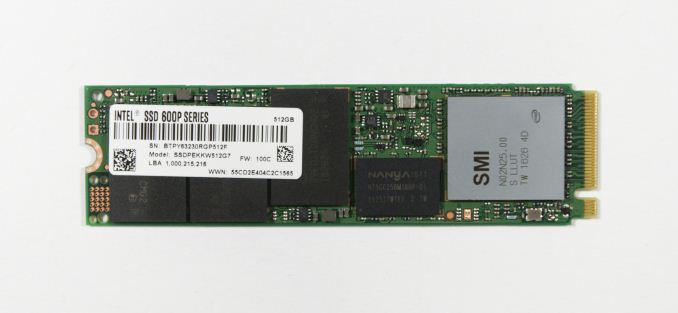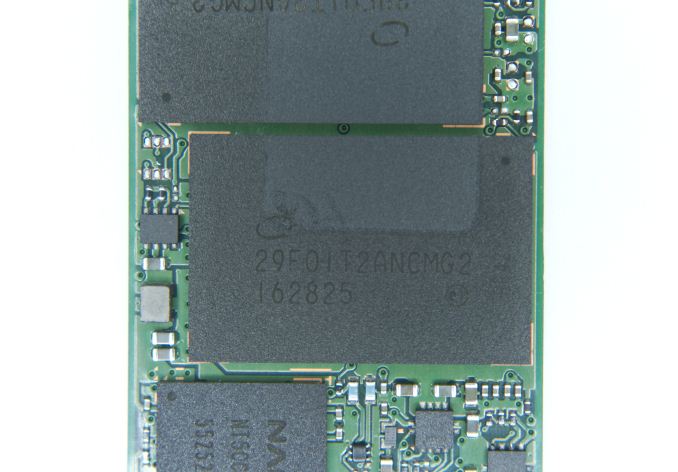The Intel SSD 600p (512GB) Review
by Billy Tallis on November 22, 2016 10:30 AM EST
Intel's SSD 600p was the first PCIe SSD using TLC NAND to hit the consumer market. It is Intel's first consumer SSD with 3D NAND and it is by far the most affordable NVMe SSD: current pricing is on par with mid-range SATA SSDs. While most other consumer PCIe SSDs have been enthusiast-oriented products aiming to deliver the highest performance possible, the Intel 600p merely attempts to break the speed limits of SATA without breaking the bank.
The Intel SSD 600p has almost nothing in common with Intel's previous NVMe SSD for consumers (the Intel SSD 750). Where the Intel SSD 750 uses Intel's in-house enterprise SSD controller with consumer-oriented firmware, the Intel 600p uses a third-party controller. The SSD 600p is a M.2 PCIe SSD with peak power consumption only slightly higher than the SSD 750's idle. By comparison, the Intel SSD 750 is a high power and high performance drive that comes in PCIe expansion card and 2.5" U.2 form factors, both with sizable heatsinks.
| Intel SSD 600p Specifications Comparison | |||||
| 128GB | 256GB | 512GB | 1TB | ||
| Form Factor | single-sided M.2 2280 | ||||
| Controller | Intel-customized Silicon Motion SM2260 | ||||
| Interface | PCIe 3.0 x4 | ||||
| NAND | Intel 384Gb 32-layer 3D TLC | ||||
| SLC Cache Size | 4 GB | 8.5 GB | 17.5 GB | 32 GB | |
| Sequential Read | 770 MB/s | 1570 MB/s | 1775 MB/s | 1800 MB/s | |
| Sequential Write (SLC Cache) | 450 MB/s | 540 MB/s | 560 MB/s | 560 MB/s | |
| 4KB Random Read (QD32) | 35k IOPS | 71k IOPS | 128.5k IOPS | 155k IOPS | |
| 4KB Random Write (QD32) | 91.5k IOPS | 112k IOPS | 128k IOPS | 128k IOPS | |
| Endurance | 72 TBW | 144 TBW | 288 TBW | 576 TBW | |
| Warranty | 5 years | ||||
The Intel SSD 600p is our first chance to test Silicon Motion's SM2260 controller, their first PCIe SSD controller. Silicon Motion's SATA SSD controllers have built a great reputation for being affordable, low power and providing good mainstream performance. One key to the power efficiency of Silicon Motion's SATA SSD controllers is their use of an optimized single core ARC processor (via Synopsys), but in order to meet the SM2260's performance target, Silicon Motion has finally switched to a dual core ARM processor. The controller chip used on the SSD 600p has some customizations specifically for Intel and bears both Intel and SMI logos.
The 3D TLC NAND used on the Intel SSD 600p is the first generation 3D NAND co-developed with Micron. We've already evaluated Micron's Crucial MX300 with the same 3D TLC and found it to be a great mainstream SATA SSD. The MX300 was unable to match the performance of Samsung's 3D TLC NAND as found in the 850 EVO, but the MX300 is substantially cheaper and remarkably power efficient, both in comparison to Samsung's SSDs and to other SSDs that use the same controller as the MX300 but planar NAND.
Intel uses the same 3D NAND flash die for its MLC and TLC parts. The MLC configuration that has not yet found its way to the consumer SSD market has a capacity of 256Gb (32GB) per die, which gives the TLC configuration a capacity of 384Gb (48GB). Micron took advantage of this odd size to offer the MX300 in non-standard capacities, but for the SSD 600p Intel is offering normal power of two capacities with large fixed size SLC write caches in the spare area. The ample spare area also allows for a write endurance rating of about 0.3 drive writes per day for the duration of the five year warranty.
Intel 3D TLC NAND, four 48GB dies for a total of 192GB per package
The Intel SSD 600p shares its hardware with two other Intel products: the SSD Pro 6000p for business client computing and the SSD E 6000p for the embedded and IoT market. The Pro 6000p is the only one of the three to support encryption and Intel's vPro security features. The SSD 600p relies on the operating system's built-in NVMe driver and Intel's consumer SSD Toolbox software which was updated in October to support the 600p.
For this review, the primary comparisons will not be against high-end NVMe drives but against mainstream SATA SSDs, as these are ultimately the closest to 'mid-to-low range' NVMe as we can get. The Crucial MX300 has given us a taste of what the Intel/Micron 3D TLC can do, and it is currently one of the best value SSDs on the market. The Samsung 850 EVO is very close to the Intel SSD 600p in price and sets the bar for the performance the SSD 600p needs to provide in order to be a good value.
Because the Intel SSD 600p is targeting a more mainstream audience and more modest level of performance than most other M.2 PCIe SSDs, I have additionally tested its performance in the M.2 slot built in to the testbed's ASUS Z97 Pro motherboard. In this configuration the SSD 600p is limited to a PCIe 2.0 x2 link, as compared to the PCIe 3.0 x4 link that is available during the ordinary testing process where an adapter is used in the primary PCIe x16 slot. This extra set of results does not include power measurements but may be more useful to desktop users who are considering adding a cheap NVMe SSD to an older but compatible existing system.
| AnandTech 2015 SSD Test System | |
| CPU | Intel Core i7-4770K running at 3.5GHz (Turbo & EIST enabled, C-states disabled) |
| Motherboard | ASUS Z97 Pro (BIOS 2701) |
| Chipset | Intel Z97 |
| Memory | Corsair Vengeance DDR3-1866 2x8GB (9-10-9-27 2T) |
| Graphics | Intel HD Graphics 4600 |
| Desktop Resolution | 1920 x 1200 |
| OS | Windows 8.1 x64 |
- Thanks to Intel for the Core i7-4770K CPU
- Thanks to ASUS for the Z97 Deluxe motherboard
- Thanks to Corsair for the Vengeance 16GB DDR3-1866 DRAM kit, RM750 power supply, Carbide 200R case, and Hydro H60 CPU cooler












63 Comments
View All Comments
Billy Tallis - Thursday, November 24, 2016 - link
They're in Bench now.Flying Aardvark - Friday, November 25, 2016 - link
I have the 1TB 600P and love it. I bought it knowing full well it wasn't a benchmark king. Don't care, low QD performance has hardly improved for quite some time. But at the price, for a 5-year warranty with 0.3% failure rate per year was a no brainer over the 960 EVO for me.I can't get it to slow down or stutter in my case and if you can, you should probably step all the way up to the Intel 750, heatsink intact and all.
crazyowl - Sunday, November 27, 2016 - link
I'm not sure now to formulate this correctly so as not to hurt the reputation of the product, but there's been a report of a 600p burning a motherboard's traces when installed via a DeLonghi adapter card. Anandtech, what could you comment on that issue? Came across it in a review for the 600p at a respectable decent online shop.crazyowl - Sunday, November 27, 2016 - link
Sorry, it was DeLock, not DeLonghi. The latter seems to be a houseware brand.Billy Tallis - Sunday, November 27, 2016 - link
Our testing showed the 600p to be relatively power hungry by the standards of M.2 PCIe SSDs, but it most certainly wasn't drawing enough current to be a danger to any equipment that is capable of safely powering other M.2 PCIe SSDs. Whatever you read about was likely the result of either a manufacturing defect in the board that was supplying power to the M.2 drive, or the result of improper installation leading to a short circuit. I've killed a motherboard through the latter means, but it was only due to the modifications I've made to facilitate measuring PCIe card power consumption.Xajel - Monday, November 28, 2016 - link
I would love to have an NVMe SSD, sadly my system is old (ASUS P8Z77 ) so, it's not able to boot from NVMe.. although nothing is wrong with the chipset it can do it, but ASUS never released any BIOS update, there's some unofficial mod's which can enable this but there's no guarantee it will work or it will brick.el-loc0 - Monday, November 28, 2016 - link
@Anandtec: what equipment do you use to measure power consumption?Billy Tallis - Tuesday, November 29, 2016 - link
For PCIe SSDs, I use a riser card from Adex Electronics with current sense resistors on the 3.3V and 12V supply lines. For SATA SSDs, I use a multimeter spliced into the power cable to measure current directly.el-loc0 - Tuesday, November 29, 2016 - link
Thanks for quick reply, Billy. Do PCIe SSD Draw Power from both lines, 3.3 V and 12 V? Do you use a current clamp or how do you measure on the riser card? Which multimeter do you use?SanX - Thursday, December 1, 2016 - link
Did Intel pay for this BS review?